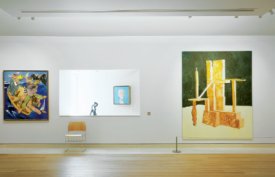Harriet Wailling explains how she made the move from university to a job in the arts via a series of voluntary internships.

At 17, I was told by careers advisors that a degree in English would open more doors than studying Art. But they failed to appreciate that art gets under the skin and exceeds academic subject boundaries. Within a year of leaving university, I returned to study for a Masters degree in Modern and Contemporary Art Theory.
While my peers joined the world of work, I was introduced to art history proper. I became engrossed and vowed that only this would suffice for a career, despite an escalating overdraft and a part-time job which barely covered the cost of living. When my MA ended, I took a part-time position lecturing on a university art foundation course, while I considered pursuing a PhD.
I also scoured the Guardian jobs website and any others that promised ‘art jobs’. They all asked for experience in museums and galleries. I had only the few hours spent invigilating in the university art gallery between lectures. By Christmas 2006 it was clear that my lecturing position alone would not secure any of these exciting positions. I set about applying to museums and galleries for every junior role advertised.
During that period, I was offered my first interview at Pallant House Gallery in Chichester. The Gallery was still part building site, but the position of Marketing Assistant seemed so completely brilliant that I enthused my way through the interview. When I was pipped at the post by someone with experience, I was gutted. But the interview had confirmed that this was the field I wanted to be in. I began hunting for work experience.
My first internship was in a major London art gallery, facilitating an interactive exhibition alongside 12 other interns. We all had degrees, MAs and PhDs, and worked for nothing or travel expenses only, on a rota of weekdays and weekends, for a minimum of six weeks. During two months there, I was introduced to marketing, education and press staff, and even managed to secure two days’ paid work. No other vacancies were forthcoming, but I was desperate to keep my hand in. It was not only a case of ‘right place, right time’, but also ‘survival of the longest lasting’, or ‘survival of those with the means to keep working without pay for months on end’.
After a second internship in the press and marketing offices of another London art gallery, I gained a part-time Education Officer position in a centre for contemporary crafts in Dorset. I lived in Sussex at the weekend, Dorset for three days a week, and London where I interned two days a week. But within two months, Pallant House Gallery called. The marketing officer position was back on the table, and the Gallery had just reopened. Would I reconsider the job?
I am now working with a team of staff who have pushed a regional gallery of modern art into the international spotlight, with a new wing designed by the architect of the British Library and one of the best collections of twentieth century British art in the world. I have been projected into a truly exciting world, talking to national press on a daily basis and getting to know an outstanding collection of collections. I worked on campaigns that saw the Gallery win numerous awards including the Gulbenkian Prize for Museum of the Year for 2007. I am now Press and Marketing Officer and Editor for the Pallant House Gallery Magazine.
My advice to art students would be to start getting experience whilst still studying, so as not to waste six months, encroaching further into overdrafts and loans whilst working for nothing. But I also hope to highlight to the industry generally the convoluted and difficult route that exists for graduates taking the first towards becoming an arts professional.
Harriet Wailling is the Marketing Officer at Pallant House Gallery in Chichester.
e: h.wailling@pallant.org.uk;
w: http://www.pallant.org.uk



